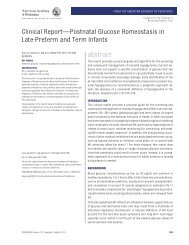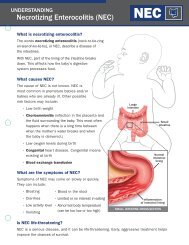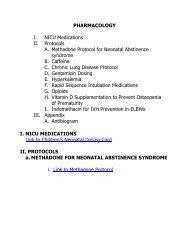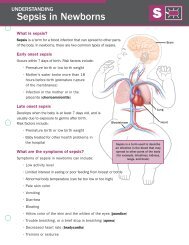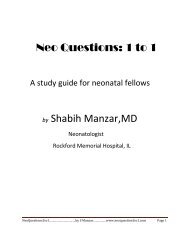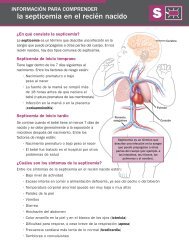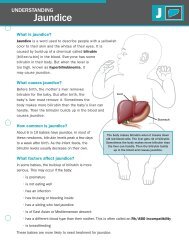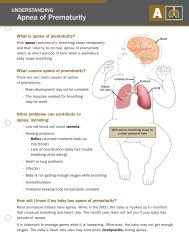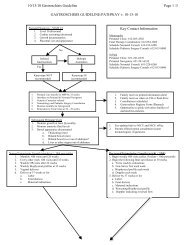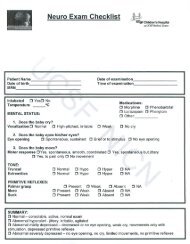Transient Tachypnea of the Newborn (TTN) - Associates in Newborn ...
Transient Tachypnea of the Newborn (TTN) - Associates in Newborn ...
Transient Tachypnea of the Newborn (TTN) - Associates in Newborn ...
Create successful ePaper yourself
Turn your PDF publications into a flip-book with our unique Google optimized e-Paper software.
81915-<strong>TTN</strong>_81915-<strong>TTN</strong> 10/24/12 1:46 PM Page 2Treat<strong>in</strong>g <strong>Transient</strong> <strong>Tachypnea</strong> <strong>of</strong> <strong>the</strong> <strong>Newborn</strong>How is <strong>TTN</strong> diagnosed?The symptoms <strong>of</strong> <strong>TTN</strong> are very similar to several o<strong>the</strong>rbreath<strong>in</strong>g problems. The health care team may run teststo rule out <strong>the</strong>se more serious problems. Tests may <strong>in</strong>clude:• Chest X-rays to look for fluid <strong>in</strong> <strong>the</strong> lungs• Blood tests to look for <strong>in</strong>fection• Constant monitor<strong>in</strong>g <strong>of</strong> <strong>the</strong> baby’s oxygen level, breath<strong>in</strong>grate, and heart rateThe diagnosis <strong>of</strong> <strong>TTN</strong> is <strong>of</strong>ten made after rul<strong>in</strong>g out o<strong>the</strong>r causes.What treatment will my baby receive?Treatments for <strong>TTN</strong> depend on how much help your baby needs tobrea<strong>the</strong> until <strong>the</strong> symptoms go away. Possible treatments <strong>in</strong>clude:• Extra oxygen – usually given through a nose tube or mask• Help feed<strong>in</strong>g – rapid breath<strong>in</strong>g can make feed<strong>in</strong>g hard.Your baby may be given fluid and nutrients through an IV ora feed<strong>in</strong>g tube until breath<strong>in</strong>g is easier.• Antibiotics – until <strong>in</strong>fection can be ruled out• CPAP (cont<strong>in</strong>uous positive airway pressure) – a treatmentthat uses mild pressurized air to keep <strong>the</strong> lungs open• Mechanical ventilator (<strong>in</strong> rare cases) – a mach<strong>in</strong>e tha<strong>the</strong>lps your baby brea<strong>the</strong> us<strong>in</strong>g a tube. The tube goesthrough <strong>the</strong> baby's nose or mouth and <strong>in</strong>to <strong>the</strong>ir throatGlossaryAntibiotics – medic<strong>in</strong>es that fight<strong>in</strong>fections caused by bacteriaCPAP (cont<strong>in</strong>uous positiveairway pressure) – a treatmentthat uses mild, pressurized air tokeep <strong>the</strong> lungs openCyanosis – bluish color <strong>of</strong> <strong>the</strong> sk<strong>in</strong>Intravenous (IV) – through a ve<strong>in</strong>Mechanical ventilator – a mach<strong>in</strong>ethat helps your baby brea<strong>the</strong> bymov<strong>in</strong>g air <strong>in</strong> and out <strong>of</strong> <strong>the</strong> lungsRetraction – sharp pull<strong>in</strong>g <strong>in</strong> <strong>of</strong> <strong>the</strong>chest muscles dur<strong>in</strong>g breath<strong>in</strong>g<strong>Tachypnea</strong> – fast breath<strong>in</strong>gAsk <strong>the</strong> health care team whenyou have questions—<strong>the</strong>y are<strong>the</strong>re to help.What will happen next?<strong>TTN</strong> usually goes away on its own with<strong>in</strong> a few days <strong>of</strong> birth. Inmost cases, <strong>the</strong>re are no long-term problems due to <strong>TTN</strong>. Talkto your health care team. They can answer any questions youhave about your baby.NOTES:______________________________________________________________________________________________________________________________________________________________________________________________________________________________________________________________________________________________________________________________________________________________Signature: __________________________________________ Date:__________________ Time: ____________© 2012 Ikaria, Inc. IMK111-01516 November 2012



